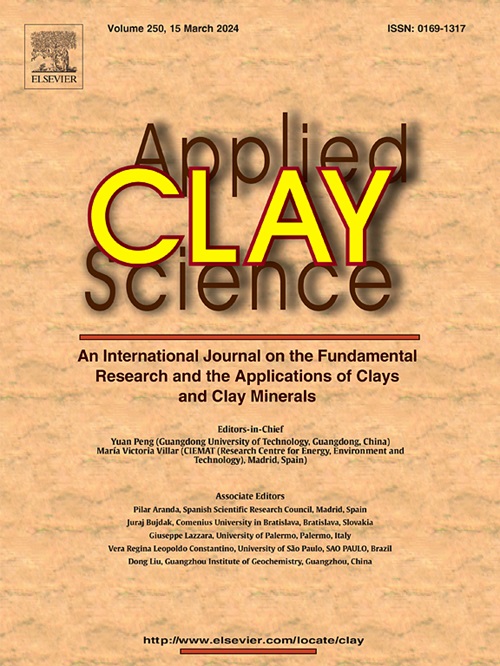坡缕石作为过氧单硫酸盐氧化相调节器加速Fe3+/Fe2+氧化还原循环
IF 5.3
2区 地球科学
Q2 CHEMISTRY, PHYSICAL
引用次数: 0
摘要
本研究采用一锅烧结法合成了一种铁基催化剂,重点研究了斜长石(Pal)对催化剂相组成的影响。坡齿石的掺入导致了与FeOCl和FeCl2的强大相互作用,从而形成了富含活性位点的多孔结构。制备的催化剂具有较高的比表面积(69.1 m2/g)和孔隙体积(0.167 cm3/g),具有交织杆状结构。这些特性对提高过氧单硫酸根(PMS)的活性至关重要。纺织废水是中国工业废水的主要来源之一,而RhB是纺织工业中常用的染料之一。在降解罗丹明B (Rhodamine B, RhB)的情况下,对合成的Fe/Pal催化剂的性能进行了评价。由于Fe3+/Fe2+的动态氧化还原循环,催化剂表现出显著的效能。在优化条件下,0.1 g/L活化催化剂在10 min内可去除85%的RhB。淬灭实验进一步阐明了污染物去除的机理,表明硫酸盐自由基和单线态氧是主要的活性物质。总的来说,这些发现强调了铁/矿物基质复合催化剂在有效处理有机污染物方面的潜力。这项研究不仅促进了对催化剂设计的理解,而且为这些材料在环境修复工作中的更广泛应用提供了有希望的途径。本文章由计算机程序翻译,如有差异,请以英文原文为准。
Accelerating of Fe3+/Fe2+ redox cycle using palygorskite as phase regulator for peroxymonosulfate oxidation
This study presents the synthesis of a Fe-based catalyst via a one-pot calcination method, emphasizing the role of palygorskite (Pal) in modifying the catalyst's phase composition. The incorporation of palygorskite led to a robust interaction with FeOCl and FeCl2, resulting in a porous structure enriched with active sites. The prepared catalyst had high surface area (69.1 m2/g) and pore volume (0.167 cm3/g) with interwoven rod-like structure. These characteristics were essential for enhancing the activation of peroxymonosulfate (PMS). Textile wastewater is one of the main sources of industrial wastewater in China, and RhB is one of the commonly used dyes in textile industry. The performance of the synthesized Fe/Pal catalyst was evaluated in the context of degrading Rhodamine B (RhB). The catalyst exhibited remarkable efficacy attributed to the dynamic Fe3+/Fe2+ redox cycle. Under optimized conditions, 0.1 g/L activated catalyst can remove 85 % RhB within 10 min. Quenching experiments further elucidated the mechanisms involved in pollutant removal, revealing that sulfate radicals and singlet oxygen were the predominant reactive species. Overall, the findings underscored the potential of iron/mineral matrix composite catalysts in the effective treatment of organic pollutants. This research not only advances the understanding of catalyst design but also offers promising pathways for the broader application of these materials in environmental remediation efforts.
求助全文
通过发布文献求助,成功后即可免费获取论文全文。
去求助
来源期刊

Applied Clay Science
地学-矿物学
CiteScore
10.30
自引率
10.70%
发文量
289
审稿时长
39 days
期刊介绍:
Applied Clay Science aims to be an international journal attracting high quality scientific papers on clays and clay minerals, including research papers, reviews, and technical notes. The journal covers typical subjects of Fundamental and Applied Clay Science such as:
• Synthesis and purification
• Structural, crystallographic and mineralogical properties of clays and clay minerals
• Thermal properties of clays and clay minerals
• Physico-chemical properties including i) surface and interface properties; ii) thermodynamic properties; iii) mechanical properties
• Interaction with water, with polar and apolar molecules
• Colloidal properties and rheology
• Adsorption, Intercalation, Ionic exchange
• Genesis and deposits of clay minerals
• Geology and geochemistry of clays
• Modification of clays and clay minerals properties by thermal and physical treatments
• Modification by chemical treatments with organic and inorganic molecules(organoclays, pillared clays)
• Modification by biological microorganisms. etc...
 求助内容:
求助内容: 应助结果提醒方式:
应助结果提醒方式:


